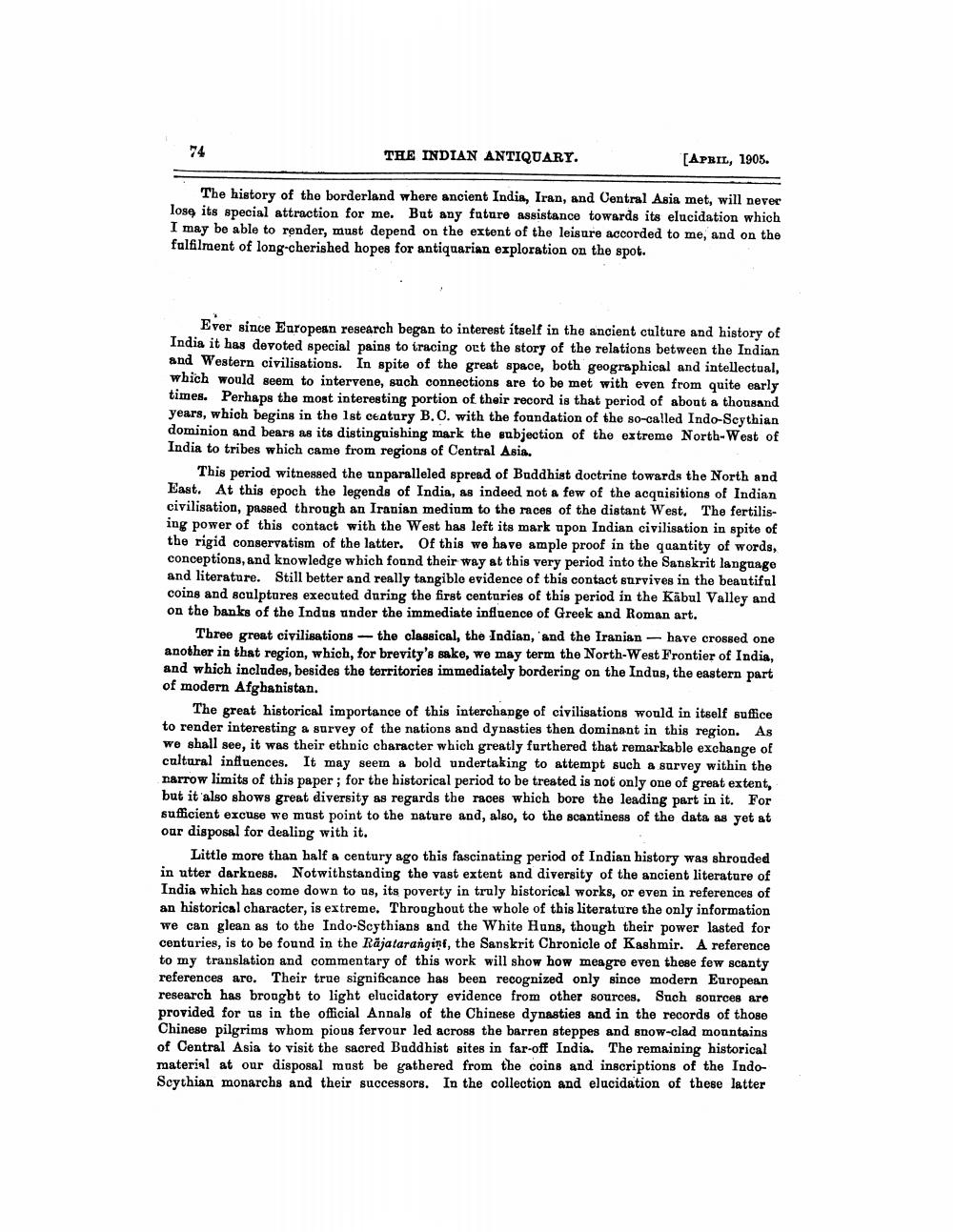________________
THE INDIAN ANTIQUARY.
[APRIL, 1905.
The history of the borderland where ancient India, Iran, and Central Asia met, will never lose its special attraction for me. But any future assistance towards its elucidation which I may be able to render, must depend on the extent of the leisure accorded to me, and on the fulfilment of long-cherished hopes for antiquarian exploration on the spot.
Ever since European research began to interest itself in the ancient culture and history of India it has devoted special pains to tracing out the story of the relations between the Indian and Western civilisations. In spite of the great space, both geographical and intellectual, which would seem to intervene, such connections are to be met with even from quite early times. Perhaps the most interesting portion of their record is that period of about a thousand years, which begins in the 1st century B.C. with the foundation of the so-called Indo-Scythian dominion and bears as its distinguishing mark the subjection of the extreme North-West of India to tribes which came from regions of Central Asia.
This period witnessed the unparalleled spread of Buddhist doctrine towards the North and East. At this epoch the legends of India, as indeed not a few of the acquisitions of Indian civilisation, passed through an Iranian medium to the races of the distant West. The fertilising power of this contact with the West has left its mark upon Indian civilisation in spite of the rigid conservatism of the latter. Of this we have ample proof in the quantity of words, conceptions, and knowledge which found their way at this very period into the Sanskrit language and literature. Still better and really tangible evidence of this contact survives in the beautiful coins and sculptures executed during the first centuries of this period in the Käbul Valley and on the banks of the Indus under the immediate influence of Greek and Roman art.
Three great civilisations - the classical, the Indian, and the Iranian - have crossed one another in that region, which, for brevity's sake, we may term the North-West Frontier of India, and which includes, besides the territories immediately bordering on the Indas, the eastern part of modern Afghanistan.
The great historical importance of this interchange of civilisations would in itself suffice to render interesting a survey of the nations and dynasties then dominant in this region. As we shall see, it was their ethnic character which greatly furthered that remarkable exchange of cultural influences. It may seem a bold undertaking to attempt such a survey within the narrow limits of this paper; for the historical period to be treated is not only one of great extent, but it also shows great diversity as regards the races which bore the leading part in it. For sufficient excuse we must point to the nature and, also, to the scantiness of the data as yet at our disposal for dealing with it.
Little more than half a century ago this fascinating period of Indian history was shrouded in utter darkness. Notwithstanding the vast extent and diversity of the ancient literature of India which has come down to us, its poverty in truly bistorical works, or even in references of an historical character, is extreme. Throughout the whole of this literature the only information we can glean as to the Indo-Scythians and the White Huns, though their power lasted for centuries, is to be found in the Rajatarangint, the Sanskrit Chronicle of Kashmir. A reference to my translation and commentary of this work will show how meagre even these few scanty references are. Their true significance has been recognized only since modern European research has brought to light elucidatory evidence from other sources. Such sources are provided for us in the official Annals of the Chinese dynasties and in the records of those Chinese pilgrims whom pious fervour led across the barren steppes and snow-clad mountains of Central Asia to visit the sacred Buddhist sites in far-off India. The remaining historical material at our disposal must be gathered from the coins and inscriptions of the IndoScythian monarchs and their successors. In the collection and elucidation of these latter




